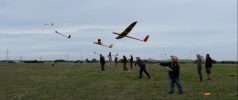Scoring example
In a hypothetical small local competition there might be 20 pilots, each flying six rounds during the day. Each round will probably be divided into 4 groups. Each group will have 5 of the 20 pilots flying against each other at the same time. Who is in which group will change each round, so everyone should flies against everyone else at least once.
Here’s what happens in Round 1 Group 1:

- Points awarded:
- Flight time: 1 point per second flight time
- Landing bonus: max 50 points (0-1m from the spot), reducing in 5 points/m increments to 5 points (9-10m from the spot)
- Points deducted:
- 0.5 points per metre launch height up to 200m, 3 points per metre launch height over 200m
- No landing bonus if landing is not within the 10 min slot
- Zero score:
- Motor restart
- Land >75m from the spot
- ADRIAN is top national pilot (they do fly local comps too). He launches right on the buzzer – as most experienced competitors do – and cuts his motor relatively low: 120m. He flies the slot out, with a time of 9 minutes 58 seconds and he lands 0.5 metres from his spot, just before the buzzer for the end of the 10 minute slot.
- BARB similarly launches right on the buzzer, cuts at 120m and lands 0.5m from her spot. But she misjudges the timing slightly: she overflies the slot, landing 1 second after the buzzer.
- CALEB is a new pilot, flying his first competition. When the buzzer goes, he very reasonably waits a couple of seconds for other planes to get out of the way before he launches, cuts his motor at 160m, flies 8 mins 45 secs and lands 3 metres from his spot.
- DAYO is also flying his first competition. He also waits a couple of seconds after the buzzer before launching, cuts his motor at 220m, flies 8 minutes 45 secs and lands 3 metres from his spot.
- EDDY launches right on the buzzer and cuts his motor at 150m. It looks like he is going to fly the slot out but he has gone a long way down wind in a weak thermal which dies on him. To avoid landing in the trees and save his model, he has to restart his motor.
The scoring looks like this (the Contest Director, like most, is using the splendid Gliderscore software):

Unsurprisingly, Adrian wins the group!
Barb’s overflight leaves her with a pretty good score of 916.7 but means she gets no landing bonus despite hitting the spot. This has a significant impact – giving her the same score she would have had as if she’d flown 9 mins 9 secs and not lost her landing bonus.
Caleb’s flight time and landing bonus are pretty good for a beginner and he can be pleased with his score of 807.8 (especially in a group which includes two expert pilots). He’ll obviously want to work on flying out the slot as often as possible and on getting as close as possible to his landing spot – why wouldn’t he? But he will probably be well advised to stick with reasonably high launches (unless he is sure he is in strong lift on launch). Launching at 120m and still flying 8:45 would have improved his score to 841.8. But launching to 120m, not finding any thermals and having a short flight would have destroyed his score!
Dayo has suffered badly from the 3s/m penalty incurred when launching to over 200m (scoring 136 less than Caleb). Top pilots will occasionally go to >200m in certain conditions but the advice for beginners is to do like Caleb: launch to a good height but make sure it’s <200m.
Eddy has a zero score because of the motor restart. Choosing not to restart the motor and landing >75m from his spot would similarly have given him a zero score. But, more importantly, choosing to restart has ensured his plane is intact – he was over the trees.
And a poor score in one round is not usually a disaster in terms of the final score: in most F5J competitions, pilots are allowed to discard their weakest round. So, here, he still manages an overall third place in the competition. But even a pretty modest score in Round 1 would have allowed him instead to discard Round 4 and moved him up to second place overall.

